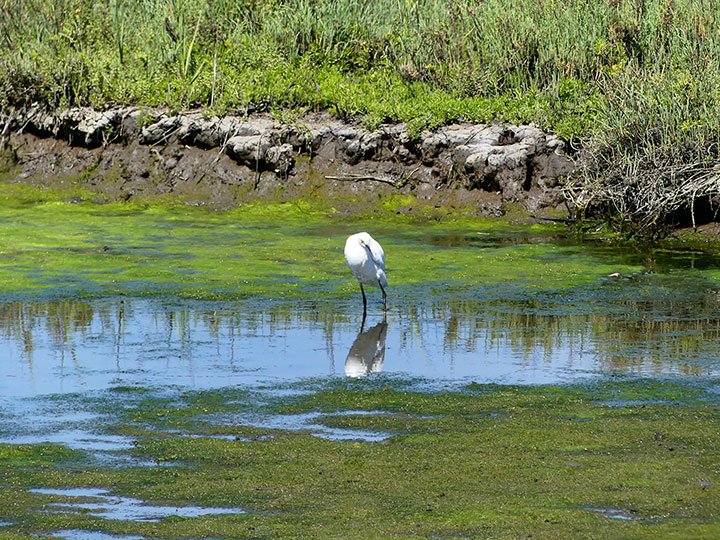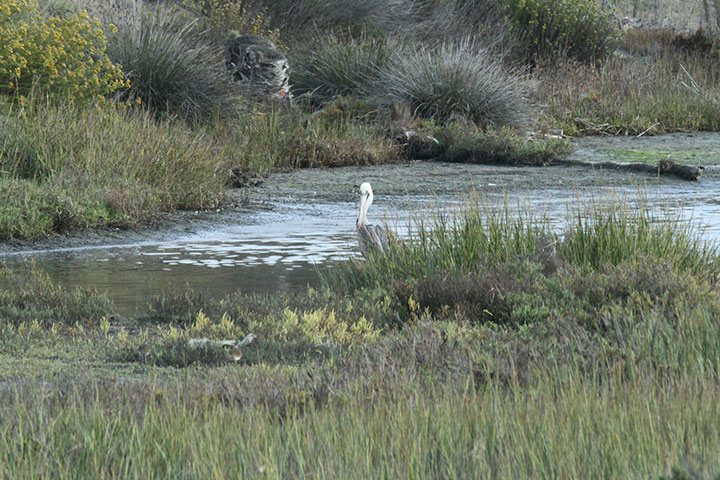 A snowy egret in the Famosa Slough SMCA (No-Take). Photo © obmissy, CC BY-NC 2.0.
A snowy egret in the Famosa Slough SMCA (No-Take). Photo © obmissy, CC BY-NC 2.0.
Famosa Slough SMCA (No-Take) protects critical estuary habitat within the greater 30-acre Famosa Slough urban wetland. Rain from the urban watershed drains down in a narrow channel towards the Pacific Ocean. At Point Loma Road, the terrain flattens, producing a shallow estuary filled with brackish water. A small island lies within the shallow estuary and serves as a nesting area for various bird species.
The circulation of fresh and salt water in and out of the slough is critical to the slough's health. Tidal waters carry nutrient- and oxygen-rich saline water into the slough, while the San Diego River and urban runoff from the local watershed brings in fresh water. The narrow tidal connection to the Pacific Ocean transports fish eggs and crustacean larvae to the wetlands.
Striped mullet, topsmelt, California killifish, and longjaw mudsuckers use this shallow reserve as nursery habitat. Shore and fiddler crabs can be seen scuttling along the marsh floor, and those with a keen eye may spot California horn snails, bay mussels, and olive snails.
Native salt marsh plants thrive in the high salinity environment. Pickleweed is a plant that absorbs and stores excess salt in the tips of jointed segments, which turn scarlet and eventually fall off. If you visit the SMCA in the fall, you can see the slough adorned by the bright scarlet tips of the pickleweed.
Over 180 species of birds visit the slough, with winter dominated by migrating waterfowl such as brant geese and northern pintails. Pelicans, avocets, yellow-crowned night herons, kingfishers, black-necked stilts and gulls frequent the slough year-round.
 A brown pelican in the Famosa Slough SMCA (No-Take). Photo © P. Simpson, CC BY-NC 2.0.
A brown pelican in the Famosa Slough SMCA (No-Take). Photo © P. Simpson, CC BY-NC 2.0.
For centuries, Native American Tribes in California have relied on marine and coastal resources. Many Native American Tribes in California continue to regularly harvest marine resources within their ancestral territories and maintain relationships with the coast for ongoing customary uses. The Kumeyaay lived on the San Diego River at a village called Kosa’aay. For thousands of years, the people migrated between the ocean and mountains, gathering seafood, acorns, and the necessities of life.
Spanish settlers were initially welcomed by the Kumeyaay, though their traditional way of life became challenged. With Spanish settlement, the land was used for cattle ranching, farming, and logging, transforming the landscape. After the United States acquired California in 1848, the area around Mission Bay was opened to homesteading and small communities grew. However, the Kumeyaay culture is resilient, with many proudly continuing their traditions with modern adaptations.
Originally, Famosa Slough was part of the Mission Bay wetland complex known as False Bay. Throughout the mid to late 1900s the Slough was gradually isolated from Mission Bay as a result of several events - channeling of the San Diego River, construction of the Ocean Beach trolley tracks, and land filling for construction. In the 1970s, local citizens became concerned when two acres were filled in for construction without permits. This sparked a move to protect the Slough via a coalition of environmental and citizen groups. Today, the City of San Diego manages Famosa Slough as a wetland preserve and, along with the Friends of Famosa Slough, they have completed several important enhancement projects to improve water and habitat quality.
 A black phoebe sits atop a sign in the Famosa Slough SMCA (No-Take). Photo © P. Simpson, CC BY-NC 2.0.
A black phoebe sits atop a sign in the Famosa Slough SMCA (No-Take). Photo © P. Simpson, CC BY-NC 2.0.
Famosa Slough SMCA (No-Take) is located within the 30-acre wetland area east of Ocean Beach. Parking is available at the southern end of the slough, off of Famosa Boulevard. A trail system runs throughout this estuary and is a great way to explore one of the last remaining wetlands in Southern California. Birdwatching is an especially popular activity here, as more than 180 different species can be observed, from migrating waterfowl to year-round resident seabirds.
This MPA is supported by the Friends of Famosa Slough, a volunteer organization that hosts nature walks, encourages scientific studies, and holds regular events to clean the slough and remove invasive plants. No take of marine resources is permitted within the SMCA; however, just down the road Ocean Beach Pier is a preferred spot for local anglers. Old Town San Diego State Historic Park is located a couple of miles east of the slough and is a great place to learn more about the early history of the area.